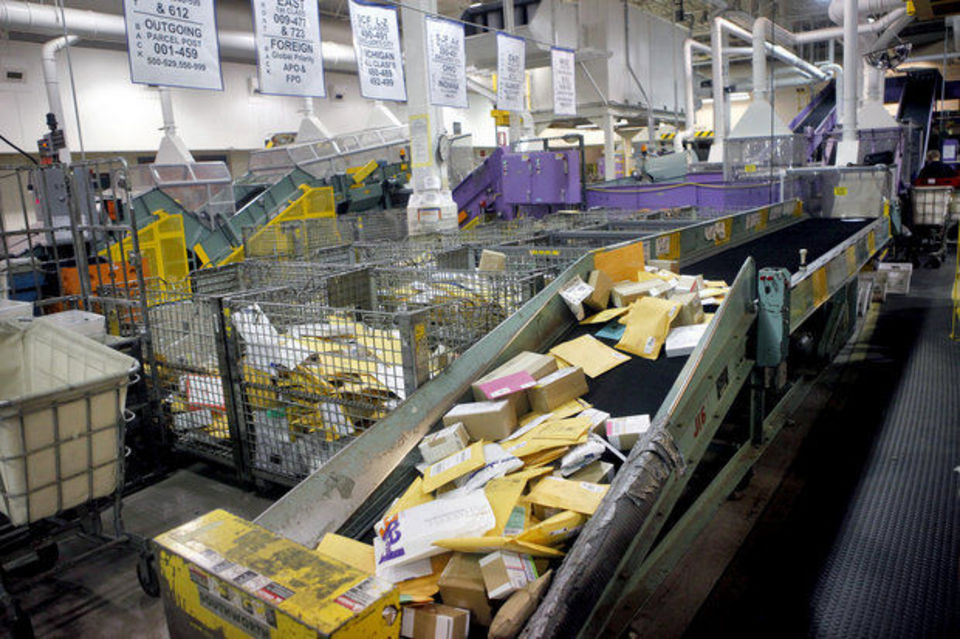
Packages line a conveyer belt as they begin the sorting process at the United States Postal Service’s Kalamazoo Processing and Distribution Center in this Sept. 23, 2009 file photo
USPS seeking to expand package sorting capability with Automated Delivery Unit Sorters (ADUS)
Automated Delivery Unit Sorter (ADUS)
The United States Postal Service (Postal Service) has issued a Request for Information (RFI for the purposes of conducting and obtaining market information regarding commercially available Automated Delivery Unit Sorters (ADUS). Such sorter application is being reviewed and explored to expand our package sorting capability in Delivery Unit environments. There is a potential future requirement for the Postal Service acquiring this type of package sorting machines having a variable number of outputs,
throughput of 1,000-5,000 pieces per hour, and having a compact footprint. Should internal business case evaluation prove positive and funding be identified, a number of ADUS systems could be acquired subsequent to completion of this market information phase.
The objective of the RFI is to research existing “commercial availability” of automated sorter solutions and identify potential sources that have demonstrated technology of a compact, modular sorting system who have delivered such product within the past three (3) years. Our review includes identifying sources having engineering resources available, as well as the manufacturing capability to meet aggressive schedules. The Postal Service may determine to meet with responding suppliers to discuss a
supplier’s design capabilities and ability to manufacture production quantities of the proposed system.
The Postal Service will assess all information received for purposes of establishing its sourcing approach for any automated delivery unit sorting program.
The Postal Service is seeks an ADUS/package sorting systems with the following selectable attributes. It is requested that responding firms address each of the below with specificity:
1. Throughput scalability of 1,000 to 5,000 packages per hour.
2. Modular configurations from 20 to 200 separations.
3. Floor space from 1,000 up to 5,000 square feet. Certain sites may have greater floor space available.
4. Maximum available height is 9 feet.
5. Maximum power requirements of 208/120 VAC / 60HZ / 3 Phase / 60 amp
6. Modularity – A modular system is preferred such that it can be configurable to accommodate installation around fixed site features such as columns.
7. Scalability – The system should be configurable to allow for various quantities of inductions and output separations. A single induction system may be adequate to achieve the performance and throughput specification.
8. Sort accuracies shall be in excess of 99.5%.
9. System reliability shall be in excess of 99.5%
10. Manufacturing Lead Time/Installation: The time to operation from contract award to beneficial use and acceptance is less than 4 months
11. Rough Order of Magnitude (ROM) system price using a minimum order of 5 and maximum of 50 systems
An example of the ADUS system is a package sorting machine having 80 separations, can sort 3,000 packages per hour and fits in 2100 square feet of floor space.
The ADUS system will receive operator oriented and placed packages from bulk containers, and it will singulate or space the packages automatically by dimension and weight.
Following singulation, the system will capture images from the packages, decode the address to identify the destination and sort
packages to the correct separation. The ADUS will be capable of handling package sizes in accordance with the information below. The separated packages will be sorted into Postal Service Material Handling Equipment such as sack racks, wire containers, tall rolling containers, hampers, etc. The overall system must facilitate the flow of unsorted mail into the machine and removal of sorted mail at the required throughput.
Respondents should identify the capability of their system to sort Postal Service mail pieces with the following characteristics:
1. Boxes. The boxes can be various shapes and sizes, even triangular in shape. The boxes can be made-up of cardboard, plastic, wood, and metal. The boxes finish can be glossy smooth to rough and used.
2. Stuffed envelops, packets, or bags. These items can come in varying shapes and sizes depending on contents. The material for envelops, packets, and bags can be but are not limited to cardboard, plastic, or Tyvek. When these items are over stuffed, they become very un-stable and may tend to rock. Note: Tyvek material has a very low coefficient of friction (f < 0.2 on
steel)
The Postal Service is seeking information no later than August 5, 2016
source: Federal Business Opportunities